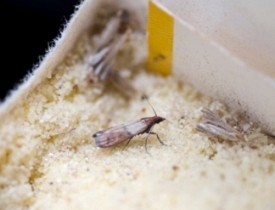Identifying and Preventing Pantry Moths
 No one wants to share their living and eating space with bugs and other pests, but even without an invitation, these critters have a way of making our homes into their homes. Pantry moths show up as unwelcome guests quite often, and they can pose a threat to your health if they get into your food and lay eggs. That’s aside from the fact that it's downright unappetizing to share your kitchen with hordes of winged creatures (and their squirmy little larvae). So if you think you might have a moth infestation in your home, find out how to identify these critters and what you must do to get rid of them.
No one wants to share their living and eating space with bugs and other pests, but even without an invitation, these critters have a way of making our homes into their homes. Pantry moths show up as unwelcome guests quite often, and they can pose a threat to your health if they get into your food and lay eggs. That’s aside from the fact that it's downright unappetizing to share your kitchen with hordes of winged creatures (and their squirmy little larvae). So if you think you might have a moth infestation in your home, find out how to identify these critters and what you must do to get rid of them.
Identify Pantry Moths
Pantry moths (also called Indian meal moths) can thrive almost anywhere inside a home, but your pantry or kitchen cabinets are the easiest place to spot them -- or see the aftereffects of them living there. To identify a pantry moth infestation:
- Check your food containers or packaging (especially plastic bags or cardboard boxes) for small holes.
- Look for webbing on the food product or packaging – or in dark corners of your cupboards.
- Examine the food inside any suspicious-appearing containers for unusual odors or unexpected stickiness and clumping. You may spot actual moth larvae.
- Take a good look around your pantry to see if you can find any moths, which look like tiny brown or copper-colored butterflies. If you don't see any, they may simply be very adept at hiding; alternatively, you could have a larvae infestation.
Get Rid of Pantry Moths
- Remove all food from the infested area and trash anything suspect in an outside garbage bin.
- Vacuum the entire area. Use a cordless, handheld vacuum if you have one, or an attachment that will allow your regular vacuum to get into crevices. Empty the vacuum immediately and dispose of the contents to avoid re-infestation.
- Scrub down all food storage containers, walls, shelves, and other hard surfaces. Use some elbow grease when you do this to get rid of any larvae still attached to the surfaces.
- Once your pantry is clean, hire a pest control expert to set up moth traps.
How Do Pantry Moths Get Inside a House?
Often homeowners inadvertently bring pantry moths into the house by purchasing dry groceries that are already infested with adults moths or larvae. This can happen even with sealed bags and boxes. Common examples of food products that have been found to contain moths include:
- flour
- pasta
- cereal
- cornmeal
- rice and other grains
- breads
- beans
- spices
- cookies
- dried fruit
- nuts and seeds
- chocolate
- powdered milk
You should be even more wary about pet food, and especially birdseed, because these products are not as tightly regulated as human foods. A good rule of thumb is to store your pet foods in the garage or a storage shed far away from your kitchen pantry.
Prevent Pantry Moths in Future
- Always maintain a clean kitchen. It's good for your health and it gives insect pests a lesser chance of surviving under your vigilant eyes.
- Inspect packaged foods for signs of infestation before you buy them. Shop at grocery stores with a high turnover, where you’re likely to be getting fresh stock.
- Kill moths and moth larvae that may come into your home with your groceries by storing grain-based food items in the freezer for the first four days after purchasing. Moths can't survive at freezing temperatures.
- Store your grain-based items in airtight containers (preferably glass, hard plastic, or metal) once you remove them from the freezer. Keep the storage area dry, using a dehumidifier if necessary.
- Place a few bay leaves in the containers with your grains to keep kitchen moths away, since they are averse to the smell of these leaves. Alternatively, leave a few cotton balls soaked with essential eucalyptus oil in the corners of your pantry.
This article was updated November 12, 2017.
Looking for a Pro? Call us (866) 441-6648

Pest control Average Costs
Exterminators Experiences

Pest Control Got Rid Of Bedbugs From A "Bargain" Headboard

Pest Control For Bee Problem So Bad We Were Afraid To Go Outside



